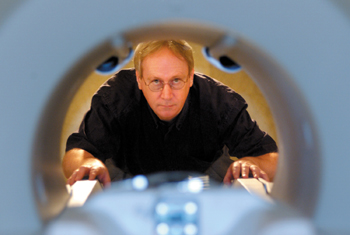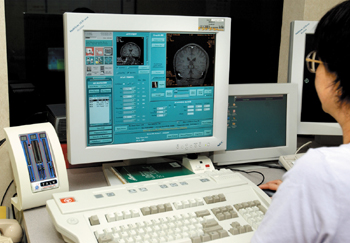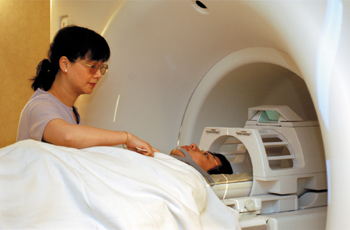
John C. Gore, Ph.D. is confident that Vanderbilt’s Institute of Imaging Science will be one of the premier research centers in the world. (photo by Dana Johnson)
Imaging institute launched — John Gore joins faculty to lead new initiative

The new institute at Vanderbilt will allow researchers to examine activity in the brain while subjects see images, hear sounds, or feel pain. (photo by Dana Johnson)

Gina Shyong, a functional MRI technician, sets up a subject for a brain scan. Functional MRI allows investigators to probe the working human brain. (photo by Dana Johnson)
John C. Gore, Ph.D. has a clear vision for the new Vanderbilt University Institute of Imaging Science — that it will be one of the top imaging research centers in the world.
Gore, internationally recognized for his magnetic resonance imaging research, joined the faculty this month as Chancellor’s University Professor of Radiology & Radiological Sciences and Biomedical Engineering and director of the new institute. He and a team of more than a dozen scientists moved to Vanderbilt from Yale University.
“Having Dr. Gore and his accomplished colleagues join our faculty adds significant strength to our research programs in both basic sciences and translational research that will benefit our patients,” said Dr. Steven G. Gabbe, dean of the School of Medicine.
Kenneth F. Galloway, Ph.D., dean of the School of Engineering, also expressed enthusiasm for Gore and his team’s recruitment and the establishment of the institute. “Their programs and the ongoing research and instruction in biomedical imaging will bring Vanderbilt to world-class status in this area,” he said. “This is terrific.”
The Institute of Imaging Science is a university-wide initiative that will bring together engineers and scientists whose interests span the spectrum of imaging research — from the underlying physics of imaging techniques to the application of imaging tools to study the brain’s inner workings. Gore’s joint primary appointments in the schools of Engineering and Medicine reflect the trans-institutional scope of the new institute, which is being supported by the participating schools and by the Academic Venture Capital Fund, a novel Vanderbilt program set up to provide financial backing for academic initiatives that will have national impact.
“It makes sense to create imaging centers that both foster the basic underlying science of medical imaging and encourage other investigators to use imaging as a research tool to address a wide range of questions,” said Gore, who also is professor of Physics and Molecular Physiology & Biophysics. “Vanderbilt understood that concept and was prepared to support it.”
The range and breadth of imaging research activities across campus attracted Gore to Vanderbilt, he said. “If we can organize the various imaging efforts and maintain scientific productivity, we already could challenge the very best places in the world.”
The new institute will have a core program of research related to developing new imaging technology based on advances in physics, engineering, and computer science, Gore said. And it will promote applied research, in collaboration with biologists and physicians who have interesting questions that imaging can address.
Gore’s appointment also affords opportunities for new educational initiatives, said Dr. Thomas R. Harris, Orrin Henry Ingram Distinguished Professor of Engineering and chair of Biomedical Engineering. Gore and his colleagues “will join with existing faculty members working in imaging to form a major teaching program in imaging science and engineering,” Harris said. The group will develop new curricular materials that include pre-college modules, undergraduate courses at several levels, and graduate courses in imaging science, he said. In addition, the new faculty will offer expanded opportunities for graduate student research and research training.
A major thrust of the new imaging institute will be research using functional magnetic resonance imaging (MRI). Functional MRI — one of the most exciting imaging advances of recent years, Gore said — allows investigators to probe the working human brain. Researchers can examine activity in the brain as subjects see images, for example, or hear sounds, or feel pain.
At Yale, Gore directed the Nuclear Magnetic Resonance Research Center, one of the leading centers in the world for magnetic resonance imaging research. In addition to using functional MRI to study the brain, Gore and colleagues are interested in fundamental issues of why magnetic resonance images look the way they do. They examine the factors, physical and physiological, that affect the magnetic resonance signal from tissues, seeking ways to improve the technology.
Gore’s team has just been awarded a Bioengineering Research Partnership grant from the National Institutes of Health. With the $4 million grant, Gore and colleagues will pursue integrated methods of imaging human cognition. “The question is how do we combine the information from functional MRI, infrared imaging, and electrophysiology,” Gore said. “And how do we optimize the information from these different technologies?”
The expertise of Gore’s group in functional MRI will bolster ongoing research at Vanderbilt, particularly active projects focused on human cognition and vision in the department of Psychology. Gore plans to explore new applications for functional MRI in studying brain development, in collaboration with Kennedy Center investigators, and in studying neurological disorders, in collaboration with investigators in Psychiatry.
“The successful recruitment of Dr. Gore and his research group forwards our programmatic development in the neurosciences,” Gabbe said.
In addition to functional MRI research, the institute will offer state-of-the-art options for small animal imaging. Imaging tools will include three new small animal MRI systems, micro-PET, and micro-CT. Gore is excited about using different imaging modalities for animal imaging. He expects the institute to make strides in using imaging to characterize genetically altered mice, for example. “The idea is to understand the connection between the underlying molecular biology and the structure and function of the whole animal,” Gore said.
Gore’s imaging research experience stretches back 30 years. He received his Ph.D. degree in Physics from the University of London, followed by postdoctoral research and a position in the department of Medical Physics at Hammersmith Hospital and Royal Postgraduate Medical School, London. He joined the Yale University department of Diagnostic Radiology in 1982. In addition to serving as director of Nuclear Magnetic Resonance Research, he founded and chaired the Biomedical Engineering Program at Yale.
Gore is a Fellow of the American Institute of Medical and Biological Engineers, the International Society of Magnetic Resonance in Medicine, and the Institute of Physics (UK). He is editor-in-chief of the journal Magnetic Resonance Imaging, an international multidisciplinary journal dedicated to both basic research and medical applications of magnetic resonance imaging.
With Gore at the helm of the Institute of Imaging Science, exciting times are ahead, said Dr. Martin P. Sandler, professor and chair of Radiology & Radiological Sciences. “We now have the institutional support and the infrastructure to make us one of the most successful imaging research facilities on both a national and an international level.”













